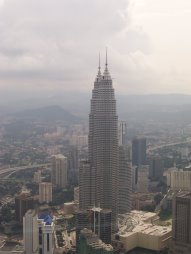Cutaway view
The Parts of an Aircraft Carrier
With about a billion individual pieces, the U.S. Nimitz-class supercarriers are among the most complex machines on earth. But on a conceptual level, they're pretty simple. They're designed to do four basic jobs:
- Transport a variety of aircraft overseas
- Launch and land airplanes
- Serve as a mobile command center for military operations
- House all the people who do these things
To accomplish these tasks, a carrier needs to combine elements of a ship, an air force base, and a small city. Among other things, it needs:
- A flight deck, a flat surface on the top of the ship where aircraft can take off and land
- A hangar deck, an area below deck to stow aircraft when not in use
- An island, a building on top of the flight deck where officers can direct flight and ship operations
- Room for the crew to live and work
- A power plant and propulsion system to move the boat from point to point and to generate electricity for the entire ship
- Various other systems to provide food and fresh water and to handle things that any city has to deal with, like sewage, trash and mail, as well as carrier-based radio and television stations and newspapers
- The hull, the main body of the ship, which floats in water
The diagrams below show how these various components fit together.
Top view
The hull of the ship is made up of extremely strong steel plates, measuring several inches thick. This heavy body is highly effective protection against fire and battle damage. The ship's structural support largely comes from three horizontal structures extending across the entire hull: the keel (the iron backbone on the bottom of the ship), the flight deck and the hangar deck.
The hull portion below the water line is rounded and relatively narrow, while the section above water flares out to form the wide flight-deck space. The lower section of the ship has a double bottom, which is pretty much what it sounds like -- there are two layers of steel plating: the bottom plating of the ship and another layer above it, separated by a gap. The double bottom provides extra protection from torpedos or accidents at sea. If the enemy hits the bottom of the ship, smashing a hole in the outer steel layer, the second layer will prevent a massive leak.
In the next section, we'll look at how a
Photo courtesy Northrop Grumman Newport News
Building an Aircraft Carrier
Since the 1950s, almost all U.S. supercarriers have been constructed at Northrop Grumman Newport News in Newport News, Virginia. To make the construction process more efficient, most of each supercarrier is assembled in separate modular pieces calledsuperlifts. Each superlift may contain many compartments (rooms), spanning multiple decks, and they can weigh anywhere from 80 to 900 tons (~70 to 800 metric tons). A supercarrier is made up of almost 200 separate superlifts.
The USS Ronald Reagan, under construction in the Northrop Grumman Newport News dry dock
Photo courtesy Northrop Grumman Newport News
Before placing a superlift module into the ship, the construction crew assembles its steel body and hooks up almost all wiring and plumbing. Then they use a giantbridge crane to lift the module and lower it precisely into its proper position inside the ship; then they weld it to the surrounding modules. Near the end of construction, the crew joins the last module, the 575-ton island, to the flight deck.
Photo courtesy U.S. Navy
Lowering superlifts into position on the USS Harry S. Truman
Photo courtesy U.S. Navy
Just like the family motor boat, an aircraft carrier propels itself through the water by spinning propellers. Of course, at about 21 feet (6.4 meters) across, a carrier's four bronze screw propellers are in a very different league than a recreational boat's. They also have a lot more power behind them. Each propeller is mounted to a long shaft, which is connected to asteam turbine powered by anuclear reactor.
The carrier's two nuclear reactors, housed in a heavily-armored, heavily restricted area in the middle of the ship, generate loads of high-pressure steam to rotate fan blades inside the turbine. The fans turn the turbine shaft, which rotates the screw propellers to push the ship forward, while massive rudders steer the ship. The propulsion system boasts something in excess of 280,000horsepower (the Navy doesn't release exact numbers).
The four onboard turbines also generate electricity to power the ship's various electric and electronic systems. This includes an onboard desalination plantthat can turn 400,000 gallons (~1,500,000 liters) of saltwater into drinkable freshwater every day -- that's enough for 2,000 homes.
Unlike the old oil-boiler carriers, modern nuclear carriers don't have to refuel regularly. In fact, they can go 15 to 20 years without refueling. The trade-offs are a more expensive power plant, a longer, more complicated refueling process (it takes several years) and the added risk of a nuclear disaster at sea. To minimize the risk of such a catastrophe, the reactors inside a supercarrier are heavily shielded and closely monitored.
For more information and more incredible and interesting information go to http://www.howstuffworks.com/





No comments:
Post a Comment